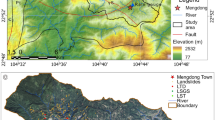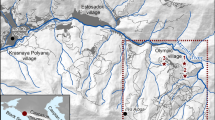Abstract
This paper focuses on the identification and analysis of the mechanisms and triggering factors of some landslides which have occurred in Campos de Jordão city, Brazil. The methodological procedures were based mainly on the recognition of the weathering profiles, recording of the landslide features, elaboration of the map of unconsolidated materials and slope and mass flow direction charts. In addition, an analysis of the rainfall data of the last 23 years was carried out. The translational type was the most common landslide that occurred, with failure surfaces between the sandy silt and sandy clay layers. Most landslides occurred in areas with slopes steeper than 30°. The rainfall data analyzed also showed that the distribution is a more important triggering factor than the amount of precipitation, such that landslides occur preferentially in the period from December to January.
Résumé
Cet article présente une analyse des processus et des facteurs déclenchants relatifs à quelques glissements de terrain qui ont eu lieu dans la ville de Campos de Jordao au Brésil. La méthodologie mise en ɶuvre a conduit à identifier les caractéristiques des glissements de terrain, caractériser des profils d'altération, élaborer une carte des matériaux sous-consolidés, une carte des pentes et des directions de propagation d'écoulements. Le glissement plan est le type de glissement le plus représenté, avec des surfaces de rupture au contact des couches de silts sableaux et d'argiles sableuses. La plupart des glissements de terrain ont eu lieu dans des régions présentant des pentes supérieures à 30°. De plus, une analyse des données pluviométriques des vingt-trois dernières années a été réalisée. Cette analyse a montré que la période des pluies représente un facteur déclenchant plus important que le total des précipitations, de sorte que les glissements de terrain ont lieu préférentiellement de décembre à janvier.
















Similar content being viewed by others
References
Collison A, Wade S, Griffiths J, Dehn M (2000) Modeling the impact of predicted climate change on landslide frequency and magnitude in SE England. Eng Geol 55:205–218
Crosta G (1997) Regionalization of rainfall thresholds: an aid to landslide hazard evaluation. Environ Geol 35:131–145
Cruden DM, Krauter E, Lefebure G, Ter-Shepanian GI, Zhang ZY (1994) Describing landslides in several languages: the multilingual landslide glossary. In: Proc Int IAEG Congr7:1325–1333
D'Orsi R, D'Ávila C, Ortigão JAR, Dias A, Moraes L, Santos MD (1997) Rio-Watch: the Rio de Janeiro landslide watch system. In: Proc Pan Am Symp on Landslides, 2, COBRAE, Rep 1, pp 21–30
Guidicini G, Iwasa OY (1976) Ensaio de correlação entre pluviosidade e escorregamento em meio tropical. Publ 1080. IPT, São Paulo, 48 pp
Hutchinson JN (1988) General report: morphological and geotechnical parameters of landslides in relation to geology and hydrology. In: Proc Int Symp on Landslides, 5, pp 3–29
Instituto de Pesquisas Tecnológicas (1978) Geologia da Região Administrativa 2 e parte da Região Administrativa 3 do Estado de São Paulo. IPT, São Paulo
Libardi PL (2000) Dinâmica da água no solo. ESALQ/USP, Piracicaba, São Paulo, 497 pp
Miyazaki T (1993) Physical laws of water flow in unconsolidated materials. In: Dekker M (ed) Water flow in unconsolidated materials. Marceli Dekker, New York
Modenesi MS (1980) Intemperismo e morfogênese no planalto de Campos do Jordão. Rev Bras Geoc 10:213–225
Ng CWW, Shi Q (1998) Influence of rainfall intensity and duration on slope stability in unsaturated unconsolidated material. Q J Eng Geol 31:105–113
Tatizana C, Ogura AT, Cerri LES, da Rocha MCM (1987) Análise de correlação entre chuvas e escorregamentos—Serra do Mar, município de Cubatão. In: Proc Anais do Congresso Brasileiro de Geologia de Engenharia, 5, 1, pp 225–236
Terlien MTJ (1997) The determination of statistical and deterministic hydrological landslide-triggering thresholds. Environ Geol 35:124–130
UNESCO (1993) Multilingual landslide glossary. The international geotechnical societies. UNESCO Working Party for World Landslide Inventory. BiTech, Richmond, British Columbia, 59 pp
Varnes DJ (1978) Slope movements, types and processes. In: Schuster RL, Krizek RJ (eds) Spec Rep 176: Landslides analysis and control. National Research Council, Washington, DC
Wolle CM, Hachich W (1989) Rain-induced landslides in southeastern Brazil. In: Proc Int Congr on Unconsolidated Material Mechanics and Foundation Engineering, pp 1639–1642
Zhang J, Jiao JJ, Yang J (2000) In situ rainfall infiltration studies at a hillside in Hubei province, China. Eng Geol 57:31–38
Author information
Authors and Affiliations
Corresponding author
Rights and permissions
About this article
Cite this article
Ahrendt, A., Zuquette, L.V. Triggering factors of landslides in Campos do Jordão city, Brazil. Bull Eng Geol Environ 62, 231–244 (2003). https://doi.org/10.1007/s10064-003-0191-8
Received:
Accepted:
Published:
Issue Date:
DOI: https://doi.org/10.1007/s10064-003-0191-8




